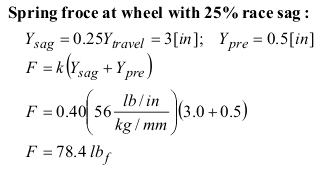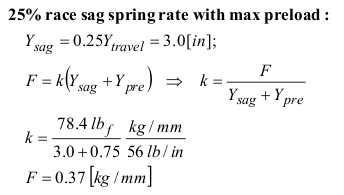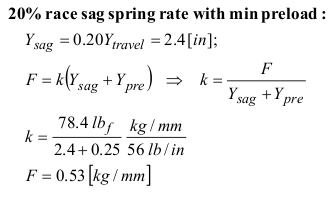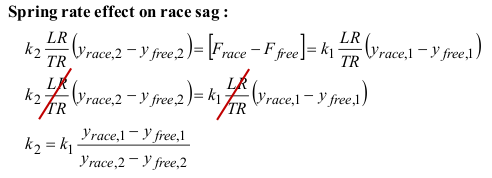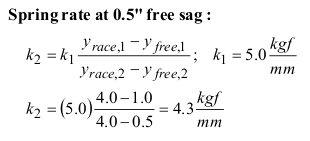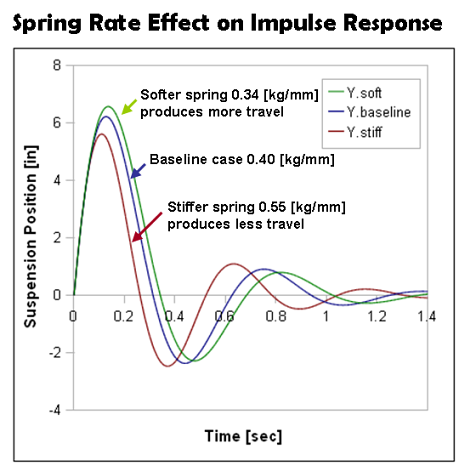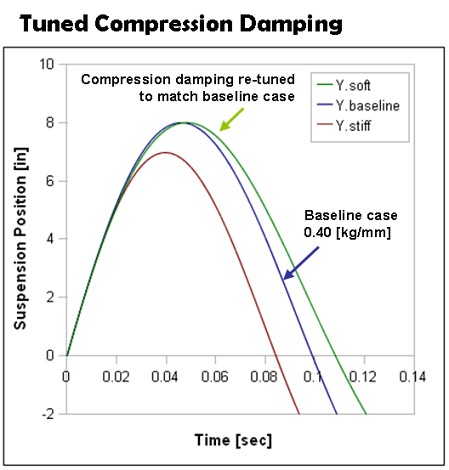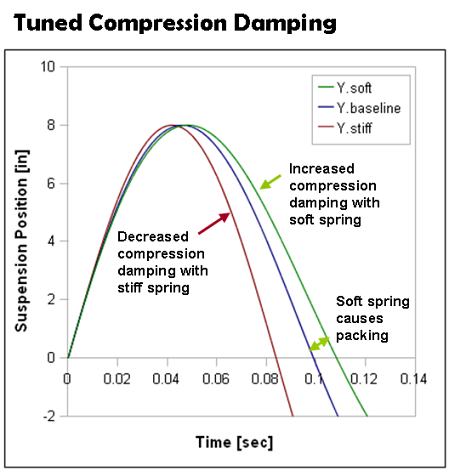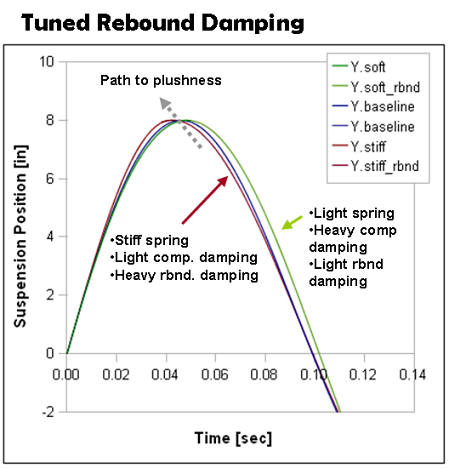

Tuning Basics
Sample Applications

ReStackor Sample Applications
Finally computer software to tune a shim stack
Spring Rate Selection
The general wisdom for dirt bike spring selection is:
-
Fork:
-
20 to 35% race sag
-
0.25 to 0.75 inch spring preload
-
-
Shock:
-
0.5 to 1.5 inches of free sag
-
33% race sag
-
Those guidelines look specific, but when applied to a 180 lb rider the spring rate range recommended by those guidelines pretty much spans the entire range of spring rates available in the Race Tech and Eibach catalog. Based on those guidelines virtually any spring could be used.
Fork Spring Rate Range:
For 12 inches of travel, 25% race sag and a spring rate of 0.40 kg/mm the force produced by the fork spring on an MX suspension setup is:
Minimum Spring Rate, Maximum Preload:
Regardless of spring rate the suspension is required to produce 78.4 lbf of force to hold up the weight of the bike plus rider at race sag. Using a softer 0.37 kgf/mm spring the target 25% race sag can be met by increasing the spring preload to 0.75":
Maximum Spring Rate At Minimum Race Sag:
Moving to 20% race sag instead of 25% reduces the fork compression by 0.6". Since race sag is set with the forks bleed there is no difference in air spring force. For 20% race sag and a spring preload of 0.25 inches the required spring rate is 0.53 kgf/mm:
Guidelines of 20 and 25% fork race sag allow spring rates from 0.37 to 0.53 [kg/mm] to be used. The spring rates available from Racetech and Eibach are:
-
0.38, 0.40, 0.42, 0.44, 0.46, 0.49, 0.52 kg/mm [Racetech]
-
0.37, 0.39, 0.40, 0.41, 0.42, 0.43, 0.44, 0.45, 0.46, 0.48, 0.50 kg/mm [Eibach]
Race sag from 20 to 25% pretty much spans the entire range of springs available from Race Tech and Eibach. The conventional guidelines of 20 to 25% race sag on a fork provides no guidance on the selection of spring rates.
![]()
Shock Linkage Ratio
Link suspensions systems have created a lot of confusion in the motorcycling community. Multiple pivot points, complex angles, year-to-year changes coupled with all of the pre-production hype have led many riders to believe linked suspensions produce complex shock compression profiles. The fact is link systems are nearly linear in the range where race sag is set. For comparing setups with the same race sag link ratios are exactly the same when the suspension is in the same stroke position.
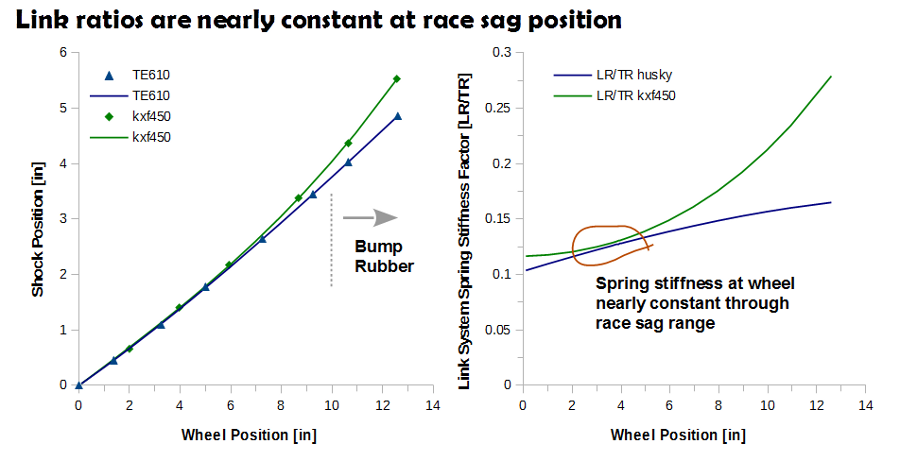
Link systems used in MX suspension setups produces a nearly linear motion at the top of the stroke. kx450 data from www.supercross-online.de
Linked suspension systems require two parameters to determine force at the rear wheel. Travel ratio [TR] defines the position of the shock shaft given the wheel position. Link ratio [LR] defines how much the shock shaft moves for an incremental change in wheel position. The ReStackor physics section works through those parameters to determine the relationship between spring force at the shock and spring force at the wheel:
Using that equation the change in force between free sag and race sag (the rider rear wheel weight) is:
Add in the assumption link ratios do not change much over the range where race sag is set and the above equation reduces to a simple ratio of race and free sag.
![]()
Shock Spring Rate Selection
The assumed baseline setup is a spring rate of 5.0 kgf/mm, four inches of race sag and one inch of free sag. If you wanted 1/2 inch of free sag the spring rate would have to be reduced to 4.3 kgf/mm:
Changing the setup to use 1.5" of free sag allows a stiffer 6.0 kgf/mm spring to be used while still matching race sag:
Letting the free sag range float between 0.5 to 1.5 inches with a constant race sag of 4.0 inches allows any spring from 4.3 to 6.0 [kg/mm] to be used. That spring rate range spans the entire range of springs available from Race Tech and Eibach:
4.4, 4.6, 4.8, 5.0, 5.2, 5.4, 5.7, 6.0 kg/mm [Race Tech]
4.3, 4.5, 4.7, 4.9, 5.1, 5.3, 5.5, 5.7, 5.9, 6.1 kg/mm [Eibach]
Guidelines of 0.5 to 1.5 inches of free sag means you can pretty much use any spring and get the right race sag. Same thing goes for a fork. Those guidelines are just too broad to be of any use selecting spring rates.
![]()
Suspension Response, What is the difference between the lightest and stiffest spring rate?
The fundamentals of spring-mass-damper theory provide the equations needed to quantify suspension response as a function of spring rate, damping and bump height. Programming the equations below into a spreadsheet gives a tool that describes suspension travel as a function of spring rate, damping and size of the initial blow, bump height.
The range of available fork spring rates (0.37 to 0.53 kgf/mm) give a race sag of 20 to 25% as worked out above. Plugging that spring rate range into the impulse response function gives the suspension bump response shown below. As expected, a softer spring produces more suspension bump travel.
Suspension response to an impulse blow can be directly computed as a function of spring rate and damping. Softer springs produce more suspension travel.
Compression Damping Tuning
Bump travel can also be controlled by changing compression damping. The suspension response equation shows the effect of compression damping changes on bump travel. By increasing compression damping the softer spring can be made to produce the same suspension bump travel as the baseline (blue curve) case. To get the same response compression damping for the soft spring case has to be increased by 44%.
Compression damping can be re-tuned for control of suspension bump travel in a motorcycle suspension setup.
A basic use of ReStackor is to figure out the shim stack modifications needed to generate some target damping curve. The baseline case in the above example has a simple tapered stack configuration generating a damping coefficient of 0.3 [lbf-s/in].
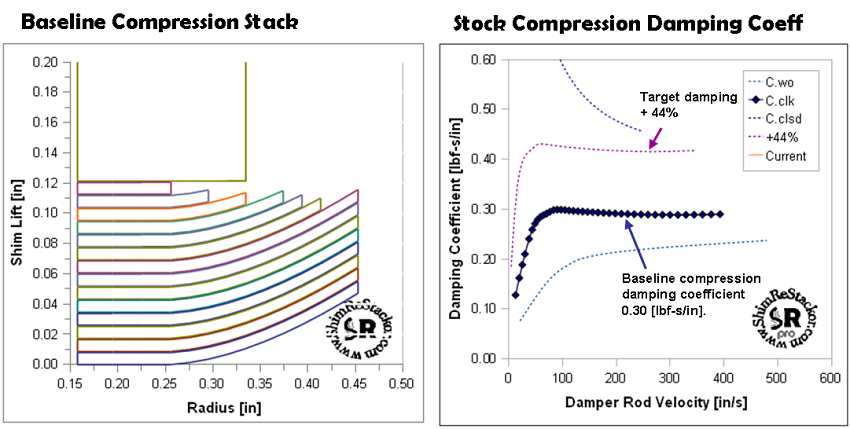
ReStackor pro calculation of compression damping coefficient for the baseline motorcycle fork suspension setup.
To get the soft spring case response to line up with the baseline case a damping coefficient increase of 44% is needed. Changing the first five 24.20 shims in the stack to thicker 24.3 shims generates that increase bringing the damping coefficient pretty close to the target +44% value. Installing that mod gives the 0.34 kgf/mm spring the same bump travel as the baseline 0.4 kgf/mm case.
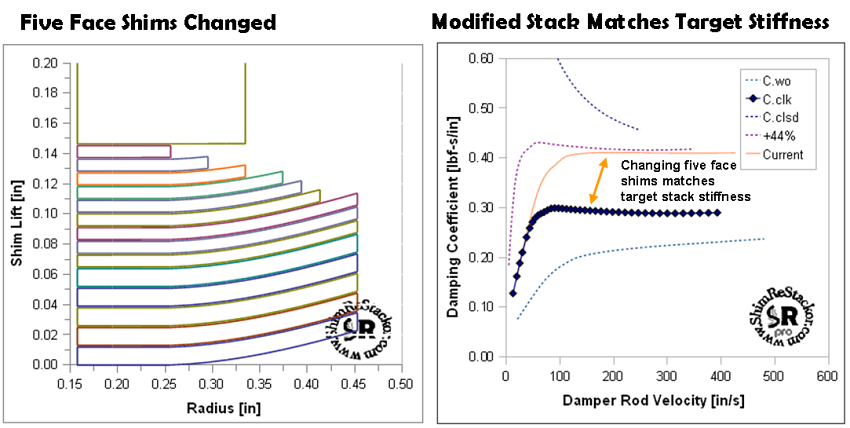
ReStackor pro calculations used to estimate stack modifications needed to control suspension travel with softer spring rate.
The stiffer spring can be made to match the response of the baseline case by reducing compression damping. With softer compression damping the stiffer spring case (red curve) produces the same bump travel as the base line case. Through tuning of the compression shim stack the suspension bump travel for all three spring rates can be made to be the same.
With modified compression damping all three spring rates produce nearly identical suspension bump travel.
With bump travel matched up it is easy to see the effect of spring rate on suspension rebound response. The softer spring produces a slower response and that slower response is going to cause the suspension to pack. To keep the suspension from packing you need a stiffer spring. By re-tuning compression damping the stiffer spring can be made to produce the same bump travel as the softer spring case.
Rebound Damping Tuning
The stiff spring case uses light compression damping and stores the bump energy in the spring. Dissipating the stored energy requires the stiffer spring case to use higher rebound damping. The light spring case uses heavy compression damping to keep the suspension from blowing through the stroke. With less energy stored in the spring the light spring case has difficulty re-accelerating the un-sprung mass of the wheel on the extension stroke. To get the light spring case below to line up rebound damping was zeroed and the suspension was still unable to match the rebound response of the baseline case using the stock spring rate.
Re-tuning the fork rebound damping sets all three spring rates to have nearly identical suspension response.
Suspension setups with a stiff spring and light compression damping get to the peak of the response curve faster (red curve). That faster wheel response allows the wheel to clear the top of the bump without jolting the bars. The soft spring case user heavier compression damping to prevent the suspension from blowing through the stroke. The stiffer compression damping takes longer go get to the maximum travel position. Since the wheel can't clear the top of the bump the bars feel a jolt. For plushness, selecting the stiffest possible spring that still uses all of the suspension travel and tuning that setup to use light compression damping and heavy rebound damping will produce the best ride.
But there is more to spring selection than bump travel. Forward weight transfer during breaking and rear transfer during acceleration generate traction. Getting those right is the central reason for changing spring rate. Once weight transfer is right damping can be tuned to control suspension travel and response as shown in the above examples.
![]()
Spring Rate Selection
Conventional motorcycling wisdom suggests spring rates based on sag:
Fork race sag: 20 to 25%; Preload: 0.25 to 0.75 inch.
Shock free sag: 0.5 to 1.5 inch; 4.0 inch race sag.
Given that range a 180 lb rider can pretty much use any spring in the Race Tech catalog and get the right sag. For any of those springs compression and rebound damping can be re-tuned to generate the same bump travel regardless of the spring rate used.
There is more to selecting a spring rate than setting your sag. Front to rear weight transfer is key:
Fork
-
If your fork spring is too stiff there will be little forward weight transfer on a corner entrance and the front wheel will push or skip over bumps.
-
If the spring is too soft the bike will tuck.
Shock
-
A soft shock spring lets the suspension fall onto the rear wheel under acceleration, pull the front wheel off the ground and run wide on a turn exit.
-
If the shock spring is too stiff there will be little weight transfer to the rear on acceleration and the bike won't hook up.
Spring selection is heavily influenced by the speed and terrain that you ride. If you are a trail rider hitting stuff at low speed a light spring works better to get full bump travel and exaggerate front to back weight transfer on a corner entrance or exit. That works for a trail setup but it is not going to be any good in a 40 mph desert sand wash. Higher speeds require stiffer springs to keep weight transfer under control. Discovering the spring rate that works for the terrain range and speeds that you ride requires tuning, plenty of seat time and an entire library of spring rates.
Summary
Suspension response, bump travel and damping are entirely dictated by the value of zeta and zeta is a simple function of mass, spring rate and damping. If the value of zeta is the same, damping response is the same regardless of mass, spring rate or damping. The value of zeta can also be retuned to get the bump response of a stiff spring to match the travel of a light spring.
When changing springs you don't have to restart damping tuning at zero. Instead you can change the shim stack configuration to keep the value of zeta the same. Or, recognizing compression and rebound are separate shim stacks, you can retune the circuits to keep bump travel the same by changing the value of zeta.

